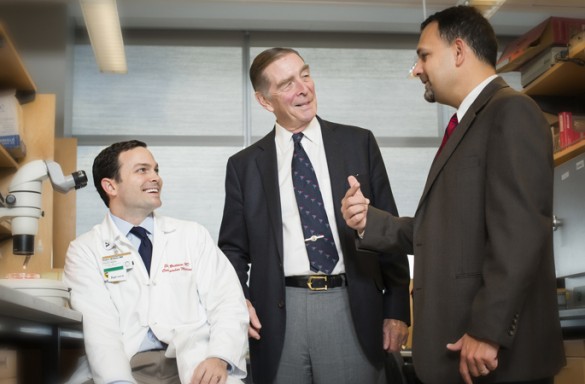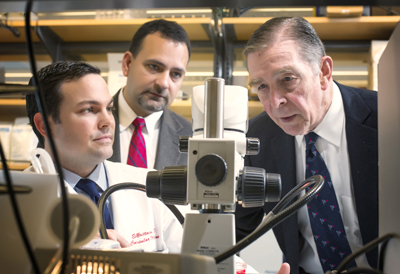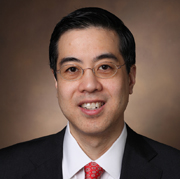
Two vastly different causes of heart failure, both of which can devastate a patient’s life, are being studied at Vanderbilt University Medical Center thanks, in part, to the generosity of a grateful patient whose own damaged heart was repaired at Vanderbilt more than five years ago.
Robbie van Roijen Jr., 76, of Orlando, Florida, is a former U.S. Marine and retired money manager who founded Orlando-based TOX Financial. After his faulty mitral valve was diagnosed by his Florida physician Robert Boswell, M.D., who trained at Vanderbilt, he was seen at Vanderbilt Heart and Vascular Institute (VHVI) by Benjamin F. Byrd III, M.D., professor of Medicine, and the valve was repaired by Michael Petracek, M.D., Cornelius Vanderbilt Professor of Surgery and chair of the Department of Cardiac Surgery.
Afterward, he wrote two checks: one to pay his hospital bill, the other, a gift to thank the hospital that he credited with saving his life. Additional gifts have followed to establish the Robert van Roijen Discovery Science Fund, a means of investing in innovative research being advanced by Vanderbilt’s young investigators.
“I was so appreciative of the fact I was still alive,” van Roijen said. “I’m very happy to donate the money and to help Vanderbilt support some of their researchers. It’s exciting to me.”
Heart failure is a chronic, progressive condition in which the heart muscle is unable to pump enough blood through to meet the body’s needs for blood and oxygen. A simple explanation is that the heart can’t keep up with its workload. According to the National Institutes of Health (NIH), heart failure affects more than 5 million in the United States, and more than 23 million worldwide.
The lifetime risk of developing heart failure is one in five, treatment costs are more than $39 billion annually in the United States alone, and the mortality rate is about 50 percent, rivaling many cancers.
Two recipients of the van Roijen Fund are Evan Brittain, M.D., M.Sc., assistant professor of Medicine and Quinn Wells, M.D., assistant professor of Medicine and Pharmacology. Both joined the Vanderbilt faculty in July 2013 and were chief fellows in Cardiology and fellow teachers of the year at Vanderbilt.
“Heart failure is one of the major cardiovascular problems,” Wells said. “You start with a normal heart, and in response to some injury your heart becomes abnormal (cardiomyopathy). It’s like a lightning bolt hits your heart,” he said, explaining that the “lightning bolt” can be a heart attack, high blood pressure, a virus or chemotherapy. A person can also be predisposed by certain genes.
Well’s research is focusing on cardiomyopathy caused by a particular type of chemotherapy: anthracyclines, used since the 1960s for a variety of cancers, particularly breast cancer. It’s a perfect example of Vanderbilt’s emphasis on personalized medicine, because his research focuses on why only some (about 5 percent) who receive this type of chemotherapy develop cardiomyopathy, and in particular, the role of genetic influences in these patients. Symptoms can manifest up to 20 years after treatment, and another 20 percent of patients receiving anthracycline therapy will have asymptomatic abnormalities in heart function, detectable through ultrasound.

BioVU, the Medical Center’s DNA repository, was used for Wells’ research. His team found 385 samples from patients who were given anthracycline therapy. Their information included measures of their heart function before and after treatment. They measured more than 1 million genetic markers in each patient and compared the degree to which they got sick, narrowing the genes down to about 10 candidates.
They also reached out to colleagues at MD Anderson, found about 180 patients who qualified for the study, looked for the same genes in that group of patients, and found one genetic marker that appears to have replicated in all patients. The finding: a gene involved in repairing DNA damage might be important in explaining why some people get sick with anthracycline therapy.
“We think this is important work that could potentially help us to understand this important toxicity, and either predict or prevent it. Parts of this research would not have been possible without Mr. van Roijen’s gift,” Wells said.
Brittain is studying right heart failure caused by the relatively rare pulmonary arterial hypertension (PAH), high blood pressure in the blood vessels that go from the right side of the heart to the lungs. With PAH, these tiny arteries in the lungs become obstructed or obliterated, and it’s harder for blood to flow through them, resulting in raised blood pressure in the lungs.
Since the right heart has to pump harder to pump blood through the arteries, the right heart muscle is weakened, eventually leading to heart failure.
Unexplained shortness of breath is one of the first symptoms of the disease, Brittain said. It’s only when abnormalities of the right side of the heart are found through ultrasound that the disease is diagnosed.
PAH occurs in 15 to 50 people per million, mostly women. It has a high mortality rate — one-half die within five years of diagnosis. It’s also an expensive disease to treat. Drugs, many in IV form, cost $20,000 to $100,000 a year.
Brittain and his team are specifically looking at abnormal heart metabolism since Vanderbilt research in a mouse model of PAH shows there are abnormalities in heart metabolism —specifically a large amount of fat is present inside the heart muscle cells.
Working with Henry Zhu, Ph.D., in the Vanderbilt Institute of Imaging Science, they are using proton magnetic resonance spectroscopy equipped with a specialized coil to detect water and fat, to measure and quantify the amount of fat inside cells inside the heart.
The next step will be determining how fat in these heart cells changes in response to interventions, which include treatment with the diabetes drug metformin. In a mouse model, the drug prevented the accumulation of fat.
“Fat is not supposed to be there. If you have an intervention that removes fat in the mouse, heart function improves. Ultimately, we need to see if the same is true in humans,” Brittain said.
A small trial of approximately 30 patients is underway at Vanderbilt, which has one of the largest cohorts of PAH patients in the world, about 700. After that, the team will try to determine whether the accumulation of fat happens early or late in the disease.
“In my case, the funding from the van Roijen fund came at a really opportune time,” Brittain said. “We were just starting to develop this technique (for diagnosing) and it gave us additional funding to accelerate enrollment and get some additional expertise.”
Tommy Wang, M.D., Gottlieb C. Friesinger II Professor of Cardiovascular Medicine and director of the Division of Cardiovascular Medicine, said that philanthropy can be critical for supporting young investigators, particularly those who may need funding to obtain preliminary data for grants.
“Though we continue to get the vast majority of our research funding from the NIH, obtaining federal grants has gotten progressively harder in recent years, and that has had a clear impact on the number of young faculty who remain in research.”
Van Roijen, who has been a member of VHVI’s Advisory Council since 2011, is no stranger to philanthropy. He invests in small companies doing medical or software research, and has provided general support to the Department of Cardiology as well.
“I love medicine and the things that are being developed. I’m very excited about what’s being done at Vanderbilt.”















